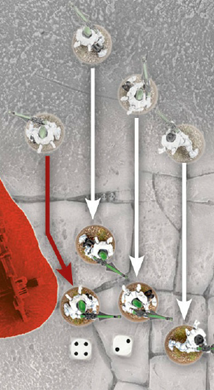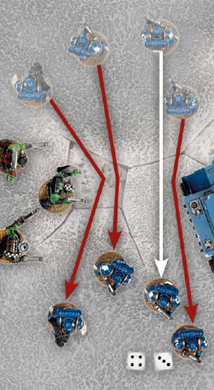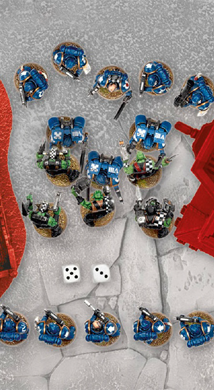It is a fortunate commander who can always rely on his troops to perform up to (and sometimes beyond) the limits of their courage. In the chaos and confusion of battle, troops can easily become demoralised, disoriented or simply terrified by the violence unleashed against them.
To represent this element of the unknown, your units have to check to see if their morale holds under certain circumstances. As you will have already gathered, particular events will require your units to take
Morale checks, and a unit in particularly dire straits may be forced to take several in a single turn.
Morale represents the grit, determination, or (sometimes) plain stupidity of warriors in action.
Morale checks are a specific kind of Leadership test.Like all other Leadership-based tests,
Morale checks (also sometimes called Morale tests) are taken by rolling 2D6 and comparing the total to the unit’s Leadership value.- If the result is equal to or less than the unit’s Leadership value, the test is passed and the unit does not suffer any ill effects – their nerve has held.
- If the result is higher than their Leadership, the test is failed and the unit will immediately Fall Back, as described later.
Some units have special rules pertaining to Morale checks that are detailed in their codex or
Army List Entry. For example, some particularly fanatical units might be immune to the effects of morale, and always pass Morale checks, while a few others always pass all Leadership tests. This is a subtle but important difference. For example, a unit that always passes Morale checks still has to test when hit by an attack with the
Pinning special rule, while a unit that always passes all Leadership tests wouldn’t.
Certain circumstances can make
Morale checks harder for a unit to pass. This is represented by applying Leadership modifiers to Morale checks, which can modify the unit’s Leadership value by -1, -2 or sometimes even more.
Occasionally, warriors will refuse to retreat even when faced with impossible odds or particularly harrowing experiences. Sometimes you can push someone just too far!
A roll of double 1 on the 2D6 always passes a Morale check, regardless of any modifiers.
The most common reasons a unit must take a
Morale check are as follows:
- Casualties: A unit losing 25% or more of its current models during a single phase must take a Morale check at the end of that phase. There is an exception: units that lose 25% or more of their current models in the Assault phase do not take a Morale check.
For example, a squad of five Space Marines suffers two casualties from enemy shooting, so it takes a Morale check, which it promptly passes. Next turn, the unit, now three strong, suffers a single casualty from a Dangerous Terrain test in the Movement phase, which is now enough for it to have to take another Morale check.- Losing an Assault: Units that lose a close combat (usually from suffering more Wounds than they inflicted) must pass a Morale check to hold their ground. If they fail, they must Fall Back. Units taking this Morale check suffer a -1 Ld modifier for each Wound their side has lost the combat by.
For example, Sergeant Kraak’s Astra Militarum squad has lost an assault against some Eldar Guardians – they killed 4, but lost 6 of their own number. They would normally require an 8 or less to pass the Leadership test, but since they have lost the fight by a difference of 2 Wounds (-2), they now require a 6 or less to hold their ground.
Sometimes retreat is the only option left to a soldier on the battlefield. A withdrawal can give troops the chance to retire to a stronger position, to regroup and mount a fresh attack, or to hold back the approaching enemy. Of course, a retreat is not without its risks.
Units make a Fall Back move immediately upon failing a Morale check – the only moves they can make in subsequent phases are Fall Back moves until they Regroup. In each subsequent
Movement phase, they will make further Fall Back moves instead of moving normally, until the unit Regroups, is destroyed or leaves the table.
Most units Fall Back 2D6". Fall Back moves are not slowed by
difficult terrain, but incur
Dangerous Terrain tests as normal. Units with models that Fall Back at different speeds always Fall Back at the speed of the slowest model in the unit.
Each model in the unit moves directly towards their own table edge by the shortest possible route. If playing a mission where there is no ‘own’ table edge, models move towards the closest table edge instead.
If any model from a unit that is Falling Back moves into contact with a table edge, the entire unit is removed from the game as casualties, as it scatters and flees the battle.
| Fall Back |
| The player rolls a 6 on the 2D6 Fall Back move, so each model is moved 6" directly towards their table edge. The leftmost model has to go around impassable terrain. | As the Space Marines Fall Back, they must move around enemies, even if this move initially carries them further away from their board edge. | As the Orks cannot Fall Back 8" without running into impassable terrain or moving to within 1" of an enemy, the entire unit is destroyed. |
|
|
Falling Back from Close Combat
Models
Falling Back from a combat can freely move through all enemy models that were involved in that combat (they have already missed the chance to catch them). This is an exception to the normal rules for moving that state that a model cannot move through a space occupied by another model. If any models would end their move less than 1" from one of these enemies, extend the Fall Back move until they are clear.
Sometimes, a unit finds its
Fall Back move blocked by
impassable terrain, friendly models or enemy models. The unit may move around these obstructions in such a way as to get back to their table edge by the shortest route, maintaining
unit coherency, even if this means moving away from their table edge. If the unit cannot perform a full Fall Back move in any direction without doubling back, it is destroyed (see diagram).
Units that are
Falling Back can only fire
Snap Shots and cannot
Run or
Turbo-boost. Units that are Falling Back cannot
Go to Ground and automatically pass
Pinning tests.
Units that are
Falling Back automatically fail all
Morale checks, but can
Regroup, as discussed next.
Falling Back and Assaults
A unit that is
Falling Back cannot charge. If it is charged, it must test to
Regroup (see
Regrouping When Assaulted, below).
Just because a unit Falls Back doesn’t mean it is out of the fight. Courageous officers will try to inspire their troops to rally. Warriors might regain their will to fight out of honour, duty or sheer bloody-mindedness.
A unit that is
Falling Back must attempt to Regroup by taking a Regroup test in their
Movement phase just before they move.
- If at least 25% of the unit’s models are still alive, or if the unit includes an Independent Character, this is a normal Leadership test.
- If less than 25% of the unit’s models are still alive and it does not contain an Independent Character, then the Leadership test can only be passed with an Insane Heroism! result of double 1. The exception to this is Regrouping when assaulted (see below).
- If the unit fails its Regroup test, then it must immediately continue to Fall Back.
- If the unit successfully passes the test, it stops Falling Back and can immediately move up to 3". This move is unaffected by difficult terrain, but Dangerous Terrain tests must be taken as normal. If the unit is out of coherency when the Regroup test is made, then the 3" move must be used to restore coherency, or as near as possible.
Once a unit has Regrouped, it cannot otherwise move (so cannot
Run in the
Shooting phase or charge in the
Assault phase). However, it can shoot (including
Overwatch), but counts as having moved and can only fire
Snap Shots.
Regrouping When Assaulted
Units that have charges declared against them while
Falling Back must always test to
Regroup as soon as the enemy is found to be within
charge range.
This test is always a normal Leadership test, and does not require Insane Heroism!, regardless of the number of models remaining in the unit.
- If the test is failed, the assaulted unit is removed as a casualty at the end of the Charge sub-phase, after all charge moves have been completed.
- If the test is successful, the unit Regroups (without moving), and the fight continues as normal.
Falling Back and Multiple Assaults
Sometimes, as part of a
multiple assault, a charging unit declares charges against one or more units that are
Falling Back as well as one or more units that are not. If the primary or secondary targets of a multiple charge are Falling Back, each retreating unit must test to
Regroup as soon as one charging model is found to be within
charge range.
Regrouping and Multiple Assaults
If the test is successful, that unit
Regroups (without moving) and the assault continues as normal. If the test is failed, the
Falling Back unit is destroyed as soon as the charging unit is found to be within
charge range and the charging model must continue its
charge move against the remaining enemy units as if the Falling Back unit was never there.




